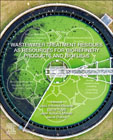
Wastewater Treatment Residues as Resources for Biorefinery Products and Energy
Dufour, Javier
Melero, Juan Antonio
Olivares, Jose Antonio
Puyol, Daniel
Wastewater Treatment Residues as Resources for Biorefinery Products and Biofuels reviews wastewater treatment processes with a view towards the use of residues. The viability of end use processes for residues such as incineration, cement additives, agricultural fertilizers, and methane production are reviewed and analyzed. The book introduces new processes for the use of residues within a fuels production system, such as pyrolysis, hydrothermal liquefaction and syngas, providing a review of technologies within these processes and analyzing their viability and productivity within scenarios optimized towards the use of residues. The final section of the book deals with newer concepts in the development of additional biomass through the treatment and removal of N/P components in wastewaters using algae. This final section dedicates two chapters towards processes for fractionation of biomass, most importantly biomass from wastewater residues, as this may likely be a critical step towards the development of specialized products. Two additional chapters are dedicated towards the production of specialized compounds from volatile fatty acids that conceptually proceed from the anaerobic acidogenisis of residues, along with the production of poly-hydroxy-alkonate (PHA) bioplastics. Finally this section ends with a final analysis of the overall productivity and viability that can be expected from these more innovative, yet focused production schemes. Discusses processes for production of High value-added products and energy development from sludgeProvides value-added technologies for resource utilization in wastewater systemsOutlines sustainability assessments and comparisons of technologies and processes INDICE: I. Wastewater Treatment as a Process and a Resource 1. Waste as a resource 2. Wastewater treatment processes 3. Characterization of wastewaters, sludge and treated waters II. Current Approaches to Disposition and Utilization of Wastewater Treatment Residues 1. Agricultural uses 2. Reduction of waste mass by incineration 3. Additives for the cement and ceramics industries 4. Anaerobic digestion for methane and hydrogen production 5. TEA, LCA and EA of wastewater and sludge treatment systems III. Technologies for Wastewater Sludge Utilization and Energy Production 1. Anaerobic digestion of sludge and biomass residues 2. Hydrothermal liquefaction of sludge and biomass residues 3. Pyrolysis of sludge and biomass residues 4. Syngas cogeneration from bio-oils 5. Fuel cells and other emerging technologies 6. TEA, LCA and EA of sludge thermochemical treatment systems IV. New Technologies for Wastewater Treatment and Value-Added Product Development A - Holistic water treatment and biomass generation 1. Wastewater treatment and biomass generation with algae 2. Purple phototrophic bacteria as a novel driver to circular economy in wastewater treatment. 3. Bioelectrochemical systems to drive resource recovery and products biosynthesis from wastewater B - Value-added products from wastewater sludge and biomass 4. Technologies for fractionation of waste residues and resource recovery, e.g.: metals; organics (amino acids, proteins, feed, etc.); nutrient recovery (e.g., phosphorous, biofertilizers); Biohydrogen and biohythane 5. Production of single-cell proteins from organic matter and residual nitrogen 6. Acidogenesis and chain elongation for bioproducts development 7. Transformation of organic contamination from wastewater into bioplastics (poly-hydroxy-alkanoate) by microorganisms
- ISBN: 978-0-12-816204-0
- Editorial: Elsevier
- Encuadernacion: Rústica
- Páginas: 512
- Fecha Publicación: 01/09/2019
- Nº Volúmenes: 1
- Idioma: Inglés
